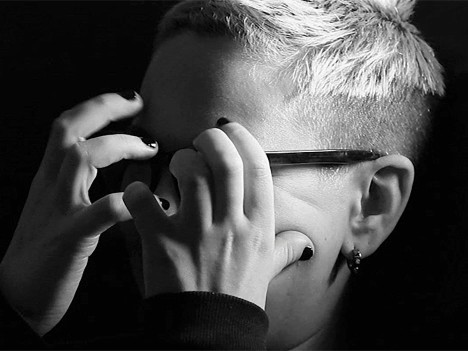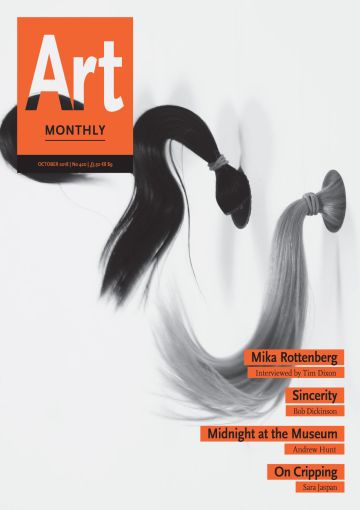Report
On Cripping
Sara Jaspan reports from an artist-led Crip Theory workshop

Leah Clements, Protection, 2018
Readers may be familiar with the term ‘crip’, but the friends, family and colleagues I mentioned it to ahead of attending ‘On Cripping’ at the Institute of Contemporary Arts – once I’d explained that the event wasn’t about the Los Angeles street gang – reacted blankly. A reclaiming of the derogatory word ‘cripple’, the term has been around since the 1970s and refers to a distinct culture of identities forged in sickness and ill-health (encompassing physical disability, chronic illness, mental illness and more). Necessarily political in stance, the crip position regards disability as being caused by the way society is organised rather than by a person’s impairment or difference and looks at ways of removing barriers that restrict life choices for crip people.
‘On Cripping’ took the form of a 90-minute series of presentations, readings and screenings by Leah Clements, Elena Colman, Alice Hattrick and Lizzy Rose – four members of a new Crip Theory Group founded by Clements (also including Rebecca Bligh and Uma Breakdown) – reflecting on their experiences as both crips and artists who identify as crips, as well as their collective aims for an upcoming residency at the Wysing Arts Centre in October. These revolved around community – forming a professional and peer- support network of fellow crip artists; advocacy – organising public talks and workshops on crip issues; and consultancy – helping art organisations to better understand and meet the needs of crip practitioners, from practical solutions like providing spaces for people with chronic fatigue or pain to lie down to introducing slower working models.
Concerning this last point, Clements states: ‘The art world is predicated on over-work, especially for those who have to hold down other jobs to make a living. If you’re sick/crip/disabled, over-work simply isn’t possible, so how do we deal with that?’ Failing to deal with it marginalises crip voices within mainstream art. Additionally, it perpetuates the wider capitalist labour model which has contributed to the rapid spread of autoimmune diseases in industrialised nations; many crip-theorists regard cripness as a form of unintended bodily resistance.
As Giulia Smith writes in ‘Health v Wealth’ (AM418), the art world is becoming more concerned with debates and practices that pivot on concepts such as health, healing and care. Indeed, the lead organiser of the event, curator Rosalie Doubal, explained that ‘I wished to start an ongoing collaboration with Crip Theory Group so that we may think together how we can best reimagine the ICA from a crip position’, and Clements reports feeling ‘really encouraged’ by interactions with the ICA and Wysing so far. There is, however, still a long way to go before we reach Clements’s ambition for a consideration of ‘cripness’ (like gender, race or sexuality) to ‘become more of a habit for anyone thinking practically and critically about art’.
Cripness is far from an issue confined to the art world, and the wider social invisibility and political silencing effect of chronic illness was discussed by all four speakers. ‘Long-term sick people are not running television channels, newspapers or art galleries,’ Rose read from her grassroots zine, chronicles, ‘mostly they are at home trying to keep themselves alive.’ Likewise, plenty of references were made to Johanna Hedva’s seminal Sick Woman Theory from 2016 in which the artist writes of being bed-bound during the Black Lives Matter protests: ‘So, as I lay there, unable to march, hold up a sign, shout a slogan that would be heard, or be visible in any traditional capacity as a political being, the central question of Sick Woman Theory formed: How do you throw a brick through the window of a bank if you can’t get out of bed?’
The presentations also addressed the need to tackle the cultural shame and stigma attached to illness, the internalised guilt of not being a ‘productive’ member of society, the common struggle for diagnosis, distrust of the medical-industrial complex and common anxieties surrounding a perceived lack of legitimacy – connected with a historical and continuing pattern of women and other marginalised groups being judged unreliable narrators of their own experience (something Hattrick explores in her forthcoming book Ill Feelings).
Against these experiences, the internet inevitably emerged as a vital social space and democratic knowledge-sharing tool for all four speakers, which, in Rose’s words, ‘has greatly expanded the experience of chronic illness’. Rose has been following a Tumblr community since 2012 that posts under the hashtag #chronicillness, and described how many of the memes ‘reveal a side of illness we don’t often see ... they spoke about illness in a way that could be difficult, funny, ungrateful, disgusting, callous, stupid or angry’. She has spent the past year in and out of hospital, documenting the experience on Instagram. Browsing her images, what’s striking is how at odds they appear on a platform (and in a society at large) which generally privileges a filtered version of reality, where users generally only publicise the ‘best versions’ of themselves, and where good health and vitality rule supreme.
While Rose’s posts are powerful in the way that they give voice to her experience of chronic illness, the event’s overriding theme of ‘voicelessness’ was eventually challenged by an audience member who asked: ‘How do you balance this with all your other identities?’ Upon entering the ICA’s Lower Gallery, the first thing that leapt out was how similar the speakers appeared: all white, female, young and not visibly disabled. To take issue with this last category seems misaligned with a non-hierarchical, all-embracing approach to illness and disability, yet for a movement that champions intersectionality, the apparent homogeneity felt odd.
The group acknowledged this as something they want to address but have found difficult to do so far. One potential explanation they gave was that cripness is not something people are often very open about, and those already experiencing other forms of marginalisation (eg transphobia or racism) may feel less willing or able to publicly identify as crips. The ICA event marked only the beginning of the group’s work and Clements stressed that ‘solidarity and intersectionality will definitely be at the front of our minds going into the Wysing residency’. She added: ‘There are crips of colour like Carolyn Lazard and Hedva doing great things. Hopefully more will be given the platform going forwards, and we can be part of achieving that.’
Though crip networks are only nascent in the UK, ‘it feels like this is a moment when people are more willing to listen, which I think owes much to the work done by queer people, people of colour and other marginalised groups’, Clements states. Though she later qualified: ‘while requirements that are more established in public consciousness like wheelchair access are still often not met, there are also other common needs that are kind of unheard of as something you could actually ask for.’
Interestingly, the movement is more developed in the US. Thinking back to Smith’s article, maybe this is partly connected to the two countries’ divergent – though increasingly similar – approaches to public healthcare. In a nation where a stint in hospital can leave citizens financially ruined, perhaps there is a more unavoidable urgency for a crip-rights movement. As the UK moves from a ‘“public-spirited holistic approach to health and community” in favour of a neoliberal model premised on the individual management of mental and physical fitness’ (Smith quoting Maria Walsh’s ‘Art: A Suitable Case for Treatment?’ from AM415), the final audience question of the afternoon – ‘Is what you’re talking about not in fact more to do with belonging to a sick society?’ – feels somewhat unsettling. Hopefully, the conversation will gain wider public attention. After all, a society with a ‘healthier’ approach to health (of all forms) would surely benefit everyone.
‘On Cripping’ took place 1 September 2018 and was part of the event programme ‘In formations’ at the Institute of Contemporary Arts, London.
Sara Jaspan is a writer and editor based in Manchester.
First published in Art Monthly 420: October 2018.








